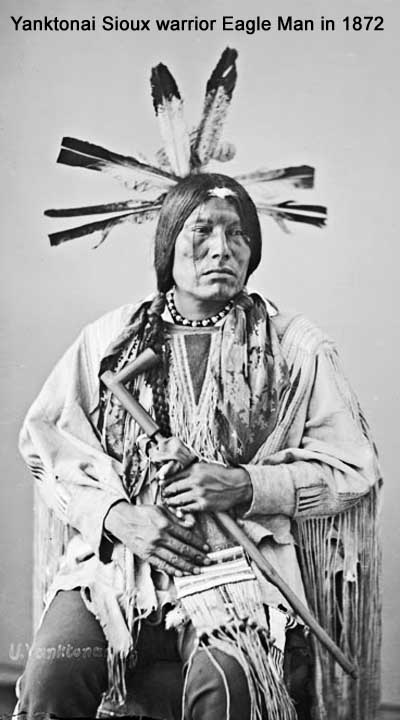|
||||||||||||
Bruce Brown's 100 Voices... Kill Eagle's Story of the Battle, #1
GRAPHIC DESCRIPTION OF THE BATTLE OF THE LITTLE BIG HORN
He commences with the date at which he left this agency, last spring, with twenty-six lodges, for the purpose of hunting buffalo and trading with hostile Indians. He speaks of having heard reports that troops were going out to punish the hostiles, but thought he would have time to do his hunting and trading and get out of the way before a battle occurred. They were obliged to hunt, as they were starving at the agency, and from his account they were very successful, killing twenty or thirty buffalo some days, and in one herd they killed all but two. He details the progress and incidents of each march. On the seventh day they arrived at Sitting Bull's village, where a feast and numerous presents of ponies and robes were given them. Efforts were made to induce Kill Eagle and his band to join in the contemplated movements and hostilities, but evidently without much success. They were desirous of getting back again to the protecting arms of the agency, but were unable to escape from the meshes of the wily Sitting Bull. They found, too late, that for them there was no escape; their horses were shot or st stolen and wounds and insults were showered upon them from every side. In the meantime the forces of Crook were approaching, and with his people Kill Eagle succeeded in escaping temporarily from the hostiles. He claims to have been distant some forty or fifty miles at the time of the Rosebud fight, and relates many of the details and incidents which he was able subsequently to gather from the participants. He places the loss of the Indians in the Rosebud fight at four dead, left on the field, and twelve that were brought to camp. He places the wounded besides at as high as 400, and says that they had 180 horses killed, besides those that were captured. He next comes to the fight on the Little Horn, and describes the Indian village, which was six miles long and one wide, and the Indians swarmed there as thick as maggots on a carcass, so numerous were they. He then goes on and speaks of Custer's approach and fight with its tragic details as an unwilling spectator rather than as a participant, who, during its progress, remained quietly in his lodge in the center of the Indian village. The fight with Reno commenced about noon, the Indians all rushing to oppose his advance, until the approach of Custer from the lower end of the village was announced, when the wildest confusion prevailed throughout the camp. Lodges were struck and preparations made for instant flight. Vast numbers of Indians left Reno's front and hastened to the assistance of their red brethren engaged with Custer, who was' steadily forced back and surrounded until all were swept from the field by the repeated charges of the Indians as if they had been carried into eternity by the irresistible. He described the firing at this point as simply terrific, and illustrated its force by clapping his hands together with great rapidity and regularity. Then came a lull in the fearful storm of iron hail and his hands were still again. The storm beat fast and furious as the thought of some loved one nerved the arm of each contending trooper. Then the movement of his hands gradually slackened and gradually grew more feeble. A few scattering shakes, like rain on a window pane, and then the movement ceased as the last of Custer's band of heroes went down with the setting sun. It was dusk as the successful combatants returned to camp littered with their dead and wounded. It had not been to them a bloodless victory. Fourteen had fallen in front of Reno, thirty-nine went down with Custer and fourteen were dead in camp. Horses and travois were laden with their wounded on every hand, and in countless numbers. One band alone, of Ogalallas, had twenty-seven wounded on travois and thirty-eight thrown across horses. Kill Eagle says it seems as if every one was wounded, and places the number as high as 600. He is very positive, however, that no prisoners were taken. There were no white men in the fight or on the field. One who had been with them went to Standing Rock Agency. The bugle calls so often spoken of were sounded by an Indian. He speaks of Sitting Bull as a heavy, muscular man, with large head and light hair hanging to his shoulders. He is not white or half-breed. He gives the names of the leading chiefs present in the fight, and reports a chief, High Elk, as being killed in front of Reno. He even goes on to speak of the approach of General Gibbon's column and the immediate flight of the Indians and the subsequent fight with Lieutenant Sibley's party, where a chief of the Cheyennes was shot through the head and instantly killed. His statement is quite lengthy, but I have endeavored to give you such portions as are of particular interest and have not before been made public. The Custer Myth: A Source Book of Custerania, written and compiled by Colonel W.A. Graham, The Stackpole Co., Harrisburg, PA 1953, p 46 - 47
Kills Alive and One Bull said Kill Eagle lied when he said he was held captive in Sitting Bull's camp on the Little Bighorn. Actually, they said, he was in council with Sitting Bull when the first reports of the Americans' sucker-punch attack came in. Here's another account by Kill Eagle.
|
||||||||||||




 BISMARK, D. T., Sept. 23, 1876. A Standing Rock letter of the 20th gives the following, of intense interest, in relation to
BISMARK, D. T., Sept. 23, 1876. A Standing Rock letter of the 20th gives the following, of intense interest, in relation to 







